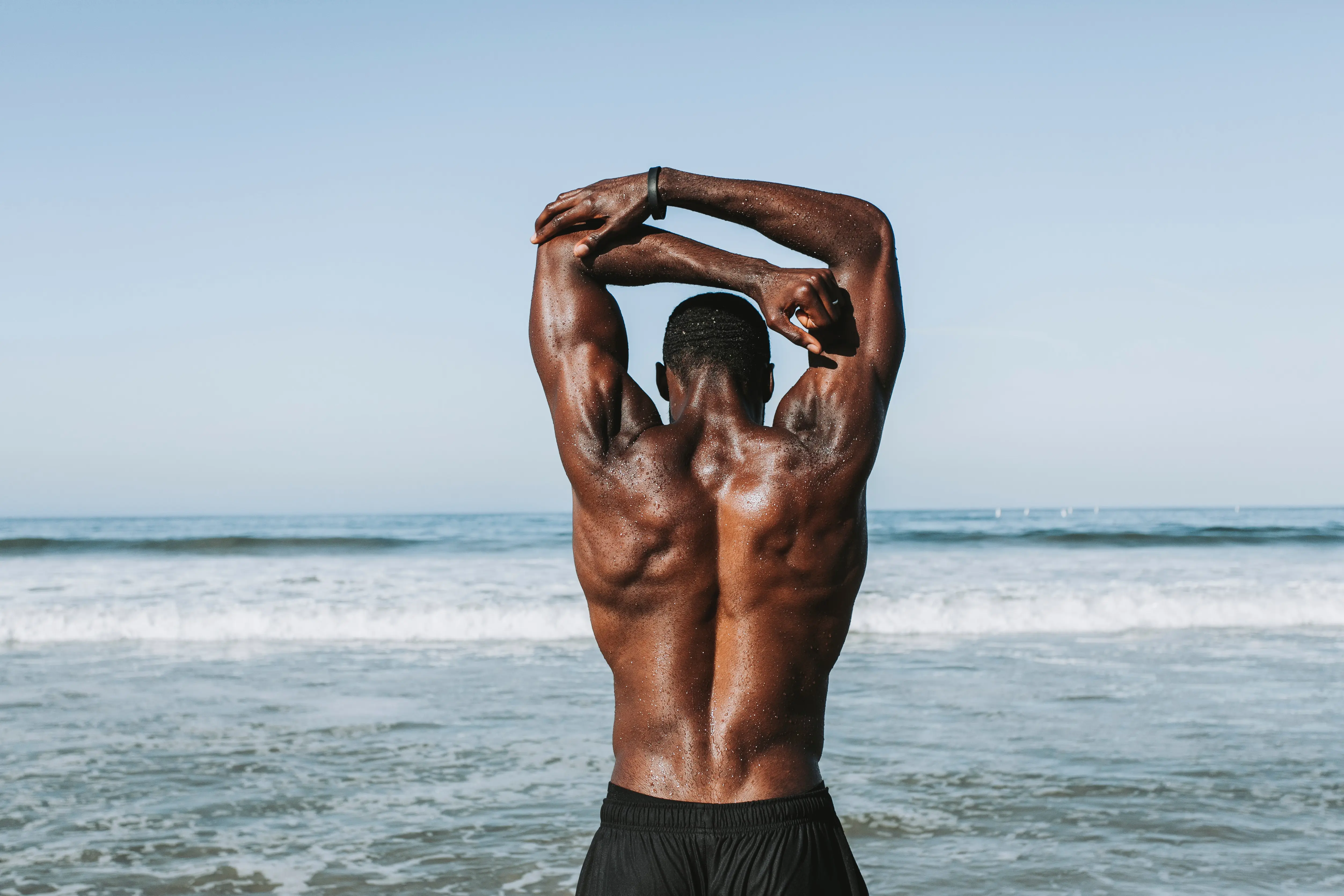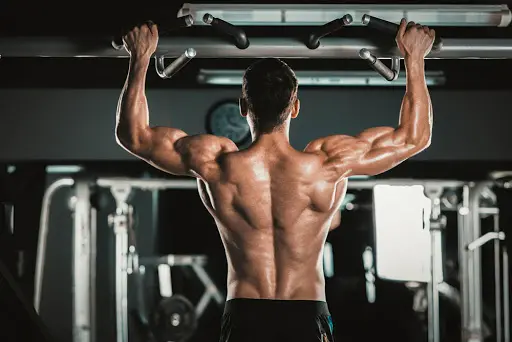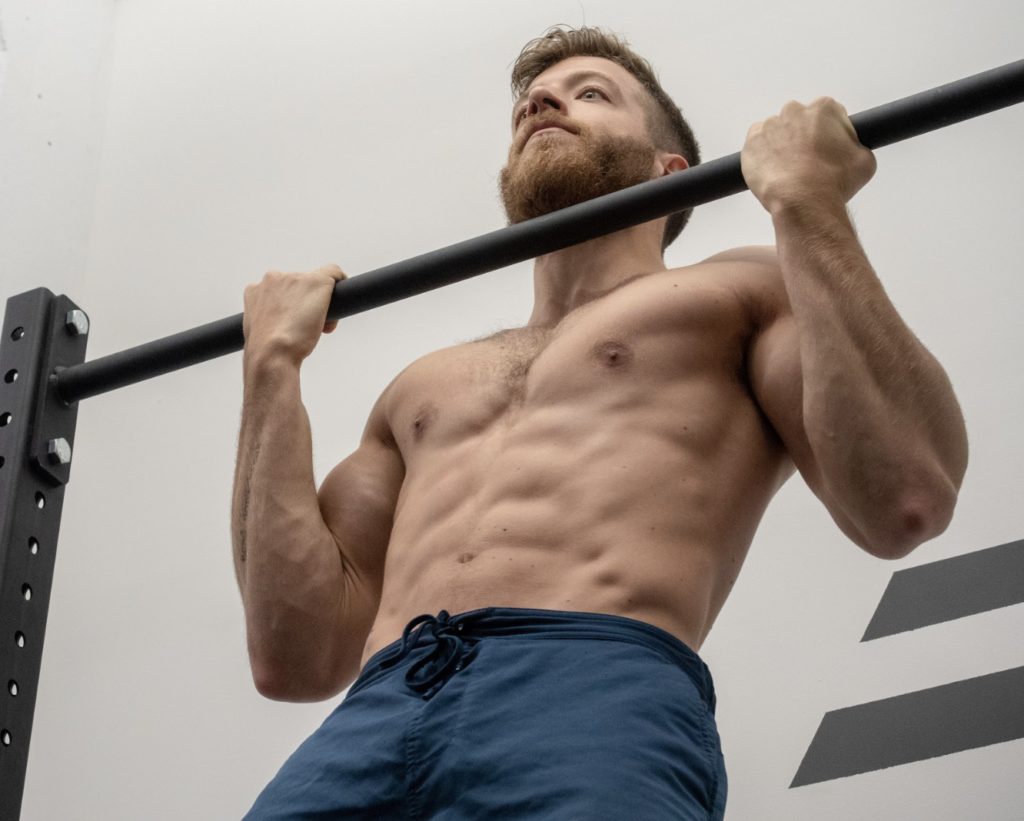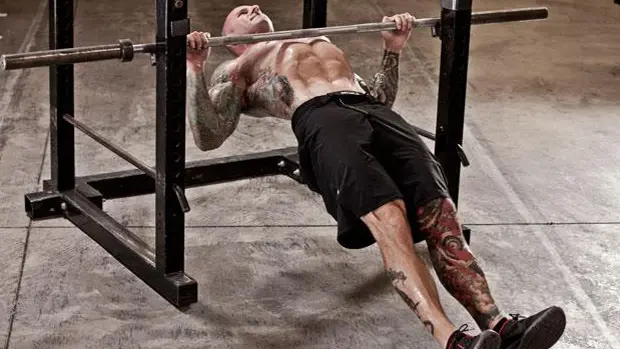
The best online fitness resource you'll ever need. We filter out the BS to ensure you meet your health and fitness goals!

The best online fitness resource you'll ever need. We filter out the BS to ensure you meet your health and fitness goals!

The back is among our biggest muscle groups: it’s an absolute powerhouse, used in almost every major compound movement.
From an aesthetic point of view, the upper back being wide and thick is key for maintaining the broad-shouldered, triangular shape so coveted by bodybuilders. From a performance point of view, it is the basis of large, heavy movements and will lend power and strength to everything you do.
However, most people think that building a strong, broad upper back takes a lot of equipment. Lat pull downs, barbell rows, deadlifts, cable rows and single arm rows all take expensive, space-consuming kit. This means either a gym membership or a garage full of thousands of pounds worth of iron- these are beyond a lot of peoples’ means and situations.
Hefting around heavy weights can also be uncomfortable or even damaging to the joints, especially as we age. Lifting heavy objects around your body can injure you if you get technique and centre of gravity wrong (which we all do sometimes) and is arguably far less stimulating than, for example, lifting your body around objects.
Never fear, though: you can build a solid, strong, large upper back with nothing but calisthenics. Bodyweight movements are all you ever need to build your perfect torso, in comfort, free from relying on any pricey equipment.
In this article, we’ll look at how this can be achieved. We’ll detail the anatomy involved in building the upper and mid back, some of the techniques you need to be aware of and some of the best exercises to schedule into your routine. Every movement will be a compound, meaning that you will be engaging a lot of muscle fibre with every rep, resulting in a very efficient, effective workout.
All you will need for the following to work for you is a pull up bar (or something similar, to perform pull ups on), a bit of energy and the drive to push yourself to hypertrophy.
For the purposes of this article, we will mostly be talking about the mid and upper back, as the lower back will typically be worked on lower body days.
The mid and upper back is where the main contractile strength is born through the posterior chain. It is also where the aesthetic value comes into play: the latissimus dorsi give the width, the traps and rhomboids give the depth, and the posterior deltoids aid in widening out the shoulders.
The superficial back muscles include the suboccipital muscles, trapezius, latissimus dorsi, levator scapulae, rhomboids and serratus posterior muscles.
Working these muscles is key, but there is far more at work than simply a handful of t-shirt muscles.
The back muscles are anatomically layered into superficial (extrinsic) and deep (intrinsic) muscles:
The vertebral column (spine) is the bony core of the back, formed by a chain of 33 interconnected vertebrae and their intervening joints. It forms the skeleton in the back region, together with the rib cage.
The spine is supported and articulated by numerous muscles, ligaments and tendons support providing it with flexibility and a great range of motion. This is one of the reasons for including large, compound movements in your workout: being able to keep your body steady under load as every joint is brought into play will help you to work every single one of these elements. This effect will never be so profound as when moving your body through space, under load, as you would in, for example, an inverted row or pull up.
Larger muscles layer over the top of these deep muscles, including the trapezius, latissimus dorsi, rhomboids, and posterior deltoids, as mentioned above. Once you’ve strengthened the base musculature beneath these muscles, and when you hit them with large, compound exercises, you will be inviting great gains to hypertrophy and strength.
Including the exercises in our list below will give you all of this: you will be working the deep muscles, every joint, ligament and tendon, alongside every single muscle through the upper and mid back.

The back has many functions. Building up a strong, stable back will have a few benefits outside of athletic movement. Holding the skeleton together with greater muscle mass that, through repeated exercise, enjoys enhanced mind-muscle connection and motor-neuron control, will always keep the body safe.
You will be less prone to injury, either internally or externally led, if you surround such a large portion of the body with dense muscle mass.
Keeping the spinal muscles strong will also aid long term postural health. This is vital for longevity both in terms of comfort and physical ability: a weak back is one of the lead causes of later life back-ache, which can be crippling in its own right.
A strong upper back will also have tremendous carry-over into other areas of athletic endeavour, alongside other movements in other planes of motion. It’s impossible to generate the power needed to survive and excel in a rugby scrum without a dense upper back. It’s hard to generate any kind of pushing power through a bench or overhead press without a strong back to act as the movement’s foundation. It’s hard to even swim a few laps with any kind of fluency of movement without the upper and mid back being in good condition.
Then there is the back’s function in its own right, as a prime mover through several key planes of motion. Rows all both train and rely on having strong back muscles. Every time you pull anything towards your body, you are using your upper back. Barbell rows, pull ups, wrestling throws, grappling… the list goes on. All of these require a well-developed back.
In addition, carrying anything, ever, takes a strong upper back. If you’re carrying something at your side (think of farmers’ carries), your lats will be tight, your shoulder girdle clenched and your traps doing most of the work. If you’re carrying it in front (like a keg carry or Atlas stone), your back muscles should be working hard to crunch the object into your body.
There is a fair amount of real-life relevance to training these functions. Training them using nothing but bodyweight will take this transference to the next level. Whenever you want to climb anything, you need your back muscles as you would for a pull up. Hence, if you’re used to moving your body through space under loaded conditions, moving through space in your daily life will be that much more effective.
Whenever something heavy needs lifting- if you are carrying heavy shopping or suitcases or helping to move some chunky furniture- your forearms, upper back and traps will be doing the work. It’s best to have these muscles in good order.
Bodyweight, calisthenic exercises are perfect for building up a large, strong, well-defined torso. They are generally simple, though hard, large compound moves that recruit a lot of muscle fibre, with a lot of stimulation, and can be done from pretty much anywhere.
Of all the aspects of your torso that can benefit from calisthenics, your back is top of the list. The sheer pulling power needed to complete each rep of most exercises is adequate to elicit hypertrophy, and the full range of joints, muscles and soft-tissue components that make up your back- and, importantly, your core stability- will be used in a variety of ways.
Whether you’re looking to build that v-shape torso, increase the functional strength and athleticism of your back, or work up your posterior muscles to aid in improving your other lifts, the three exercises we have picked below will get you there. They are all row variations, as you might expect, though we will also show you how to use them isometrically and concentrically.
Also, as you might expect, they are all variations on the classic pull up. There really is no other competition for the top spot.

Pull ups are king when it comes to training your upper body. They work the lats and biceps intensely, eliciting a great deal of hypertrophy with each set. They also require a lot of your core muscles: your trunk will have to be as steady as a rock if you’re going to get in any amount of good quality pull ups. The strength needed to complete them is vast, and the strength progression profound.
In fact, every muscle north of your waist will feel pull ups to a greater or lesser degree, and most upper body programs will contain them as something of a bedrock- if you do nothing else for your back but pull ups, you will get the results you’re looking for.
We’ve picked wide grip pull ups partly because they are quite a hard variation, partly because they really work your latissimus dorsi, giving you that v-shape, and partly because they emphasise different components of the pull up to the close grin chip up, which we have included below.
To perform wide grip pull ups:
Start by standing underneath a pullup bar, with your back and spine straight.
If you need an easier variation to get starter, try using a resistance band. Loop one end over the bar and the other over your feet, so that its elasticity assists you in pulling yourself up to the top. For a harder variation, try using a weighted belt or holding a dumbbell between your feet.

Chip ups work your lats from a different angle to pull ups, particularly wide grip pull ups, and will really light your biceps up. The movement is more mechanically secure than the pull up, meaning that it will be more appropriate for beginners, or those looking to hit higher rep ranges.
To perform chip ups:
As with pull ups, resistance bands can be used to make chin ups easier, and added weights can be used to make them more challenging.

Inverted rows are great for beginners, for super setting with other movements, specifically pushing movements, and for finishing off your workout with very high rep ranges. They are perfect for hypertrophy and endurance and can be far more easily modified to accommodate different resistance ranges than pull ups or chin ups.
To perform inverted rows:
To make this easier, bring your feet in closer to your body, breaking the straight line of your body. Alternatively, use a higher bar, creating a greater angle between your body and the floor. To make it harder, use a lower bar, with your body as close to parallel with the ground as possible.
So, how can we use these exercises in a comprehensive, calisthenic workout for the back? How should we structure them to make the most out of each exercise for a variety of factors?
The routine below will begin with harder, strength building exercises, at high resistance and lower rep ranges. Then we will run through some assistance work, at lower resistance and higher intensity. This means that following it will give you a good-quality strength workout accompanied by a great deal of hypertrophy.
Set a timer for ten minutes. Complete one round of the following superset at the beginning of every minute.
This should have the key components of your back nice and warm for the main exercise, pumped full of blood and oxygen, and perfectly primed to work hard.
The pull ups will be the main strength building exercise in this routine, whilst plank will prime your body for its brace whilst bringing the deep core muscles into play. If 5 pull ups are too easy, consider adding weights, as above.
For isometric chin ups, do as instructed in our exercise list above. However, rather than pulling yourself to the top, jump up, then hold yourself at the top for a count of 5. Then, you have the option of lowering yourself slowly, or simply dropping out of the movement before jumping up for the next rep.
Again, the layouts or hollow rocks will work those deep core muscles that are key to maintaining a strong, healthy back and to managing the demands of hefty pull ups.
Inverted rows can obviously be performed to higher rep ranges, which is very useful for hypertrophy. Feel free to use TRX ropes for these, or any of the other methods listed above- just make sure that 16 reps are achievable yet challenging and bring down the resistance set by set if needed. Follow the advice in this article, use the calisthenic back exercises we’ve listed, and set them to a routine like the one we’ve run you through, and your back will know about it. You will fatigue quickly, at any level, and will find yourself experiencing some quite profound hypertrophy and strength gains, all whilst using limited equipment and little else but your bodyweight.